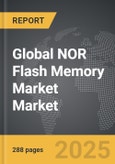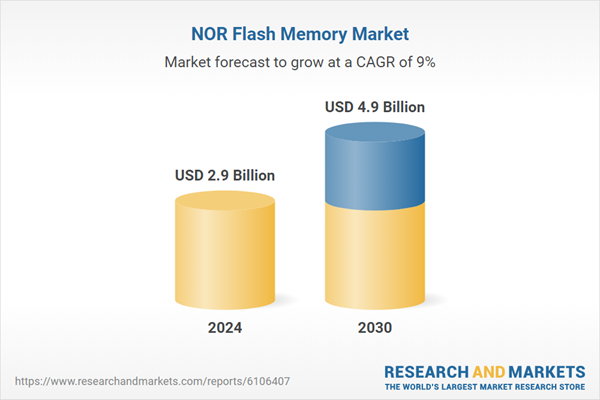Global NOR Flash Memory Market - Key Trends & Drivers Summarized
What Is Driving Renewed Interest in NOR Flash Memory Technologies?
NOR flash memory is seeing growing relevance due to its unique advantages in embedded applications. Unlike NAND flash, NOR flash allows random access to memory locations, making it better suited for code storage in embedded systems. This attribute is critical for automotive electronics, medical devices, industrial controllers, and consumer electronics where reliability and data integrity are priorities. As embedded systems become more complex and distributed, NOR flash is preferred for executing code directly from non-volatile memory. Moreover, growing demand for reliable boot code storage in connected devices and microcontrollers has reinforced the adoption of NOR flash in modern electronics design.Advanced microcontroller-based designs often require memory solutions with fast read access and reliable endurance, both of which are inherent strengths of NOR flash. This has positioned NOR flash as an essential component in low-power systems with high reliability requirements. The steady demand from security systems, control modules, and wearable devices is ensuring consistent market relevance. Furthermore, as device manufacturers prioritize secure memory execution, NOR flash is being integrated into designs requiring secure boot processes and firmware execution. It continues to serve a critical function in applications where data corruption or delayed access can disrupt performance or safety.
How Is NOR Flash Memory Evolving in Response to Industry Shifts?
The NOR flash memory landscape is undergoing subtle shifts influenced by changes in electronics design and performance requirements. One noticeable trend is the expansion of NOR flash into applications previously served by low-density NAND or serial EEPROMs. This is due to enhancements in serial interface technologies like SPI NOR, which offer faster read speeds and lower pin counts. These advancements support compact packaging and reduce board space, aligning well with design trends in consumer electronics and industrial IoT. Moreover, increasing demand for instant-on functionality across sectors such as automotive infotainment and smart appliances is prompting greater use of NOR flash over other non-volatile options.Manufacturers are also focusing on optimizing die sizes and introducing more efficient fabrication processes to keep costs in check for mid-density NOR flash products. At the same time, innovations in multi-level cell (MLC) technologies are enabling NOR flash to increase density without compromising reliability. This is particularly relevant in automotive and aerospace sectors, where extended temperature support and endurance are essential. Additionally, automotive electronics continue to integrate more infotainment, driver assistance, and connectivity features, all of which demand reliable memory that supports frequent code execution. These developments are expanding NOR flash memory's footprint in systems once considered marginal or static in terms of memory needs.
Where Are End-Use Applications Increasing Demand for NOR Flash?
Rising complexity in end-use systems is driving demand for memory components that balance performance, stability, and space efficiency. In automotive applications, the trend toward electrification and autonomous features is expanding the use of NOR flash in ADAS units, instrument clusters, and digital cockpits. These systems depend on high-integrity code storage that allows real-time updates and frequent read cycles, both of which align with NOR's characteristics. Similarly, the industrial sector is deploying NOR flash in programmable logic controllers, remote monitoring tools, and intelligent edge devices where fast access and high endurance are essential.Consumer electronics, especially wearable devices, are increasingly adopting NOR flash due to its compact form factor and low power consumption. These devices often require small yet dependable memory to handle boot operations, user interface software, and localized data logging. NOR flash also plays a role in telecom and networking equipment, where it stores configuration settings, firmware, and logs that must remain stable during power cycles. In medical electronics, devices such as portable diagnostic equipment and monitoring tools rely on NOR flash for system initialization and secure storage of critical code, especially in scenarios where system failure poses safety risks.
Growth in the NOR Flash Memory market is driven by several factors…
Growth in the NOR flash memory market is driven by several factors rooted in technological advancement and end-use evolution. Transition from parallel to serial NOR interfaces is significantly boosting adoption due to benefits in board design efficiency and system scalability. Increasing adoption of SPI NOR flash in IoT modules and smart sensors is also supporting market expansion. Another important factor is the rising preference for memory with extended temperature ranges and automotive-grade endurance, especially in electric vehicles and connected car platforms. Integration of NOR flash in automotive domains like electronic control units and infotainment systems is becoming more prevalent as functional safety and real-time responsiveness become essential.In industrial automation, demand for robust memory in control systems, factory sensors, and real-time process monitoring units is reinforcing the relevance of NOR flash. Applications requiring deterministic read access and low failure tolerance continue to rely on NOR rather than NAND. In consumer technology, miniaturization and power constraints are favoring NOR flash in wearables and personal health monitoring devices. Lastly, increasing reliance on secure boot processes and embedded firmware in a wide range of electronics has made NOR flash an indispensable memory solution in sectors requiring long-term software stability and device longevity.
Report Scope
The report analyzes the NOR Flash Memory market, presented in terms of market value (US$). The analysis covers the key segments and geographic regions outlined below:- Segments: Type (Serial NOR Flash Memory, Parallel NOR Flash Memory); End-Use (Consumer Electronics End-Use, Communication End-Use, Automotive End-Use, Industrial End-Use, Other End-Uses).
- Geographic Regions/Countries: World; United States; Canada; Japan; China; Europe (France; Germany; Italy; United Kingdom; Spain; Russia; and Rest of Europe); Asia-Pacific (Australia; India; South Korea; and Rest of Asia-Pacific); Latin America (Argentina; Brazil; Mexico; and Rest of Latin America); Middle East (Iran; Israel; Saudi Arabia; United Arab Emirates; and Rest of Middle East); and Africa.
Key Insights:
- Market Growth: Understand the significant growth trajectory of the Serial NOR Flash Memory segment, which is expected to reach US$3.4 Billion by 2030 with a CAGR of a 10.3%. The Parallel NOR Flash Memory segment is also set to grow at 6.6% CAGR over the analysis period.
- Regional Analysis: Gain insights into the U.S. market, valued at $799.8 Million in 2024, and China, forecasted to grow at an impressive 14.2% CAGR to reach $1.1 Billion by 2030. Discover growth trends in other key regions, including Japan, Canada, Germany, and the Asia-Pacific.
Why You Should Buy This Report:
- Detailed Market Analysis: Access a thorough analysis of the Global NOR Flash Memory Market, covering all major geographic regions and market segments.
- Competitive Insights: Get an overview of the competitive landscape, including the market presence of major players across different geographies.
- Future Trends and Drivers: Understand the key trends and drivers shaping the future of the Global NOR Flash Memory Market.
- Actionable Insights: Benefit from actionable insights that can help you identify new revenue opportunities and make strategic business decisions.
Key Questions Answered:
- How is the Global NOR Flash Memory Market expected to evolve by 2030?
- What are the main drivers and restraints affecting the market?
- Which market segments will grow the most over the forecast period?
- How will market shares for different regions and segments change by 2030?
- Who are the leading players in the market, and what are their prospects?
Report Features:
- Comprehensive Market Data: Independent analysis of annual sales and market forecasts in US$ Million from 2024 to 2030.
- In-Depth Regional Analysis: Detailed insights into key markets, including the U.S., China, Japan, Canada, Europe, Asia-Pacific, Latin America, Middle East, and Africa.
- Company Profiles: Coverage of players such as Abbott Laboratories, Astellas Pharma Inc., AstraZeneca PLC, Bayer AG, BioMarin Pharmaceutical Inc. and more.
- Complimentary Updates: Receive free report updates for one year to keep you informed of the latest market developments.
Some of the 48 companies featured in this NOR Flash Memory market report include:
- Cypress Semiconductor Corporation
- Eon Silicon Solutions Inc.
- GigaDevice Semiconductor Inc.
- Infineon Technologies AG
- Integrated Silicon Solution Inc. (ISSI)
- Intel Corporation
- Macronix International Co., Ltd.
- MediaTek Inc.
- Microchip Technology Inc.
- Micron Technology, Inc.
- Nanya Technology Corporation
- NXP Semiconductors
- Qualcomm Incorporated
- Renesas Electronics Corporation
- Samsung Electronics Co., Ltd.
- Seagate Technology LLC
- Spansion LLC
- Toshiba Corporation
- Winbond Electronics Corporation
- Wuhan Xinxin Semiconductor Manufacturing Co.
- XTX Technology Limited
This edition integrates the latest global trade and economic shifts into comprehensive market analysis. Key updates include:
- Tariff and Trade Impact: Insights into global tariff negotiations across 180+ countries, with analysis of supply chain turbulence, sourcing disruptions, and geographic realignment. Special focus on 2025 as a pivotal year for trade tensions, including updated perspectives on the Trump-era tariffs.
- Adjusted Forecasts and Analytics: Revised global and regional market forecasts through 2030, incorporating tariff effects, economic uncertainty, and structural changes in globalization. Includes historical analysis from 2015 to 2023.
- Strategic Market Dynamics: Evaluation of revised market prospects, regional outlooks, and key economic indicators such as population and urbanization trends.
- Innovation & Technology Trends: Latest developments in product and process innovation, emerging technologies, and key industry drivers shaping the competitive landscape.
- Competitive Intelligence: Updated global market share estimates for 2025, competitive positioning of major players (Strong/Active/Niche/Trivial), and refined focus on leading global brands and core players.
- Expert Insight & Commentary: Strategic analysis from economists, trade experts, and domain specialists to contextualize market shifts and identify emerging opportunities.
Table of Contents
Companies Mentioned (Partial List)
A selection of companies mentioned in this report includes, but is not limited to:
- Cypress Semiconductor Corporation
- Eon Silicon Solutions Inc.
- GigaDevice Semiconductor Inc.
- Infineon Technologies AG
- Integrated Silicon Solution Inc. (ISSI)
- Intel Corporation
- Macronix International Co., Ltd.
- MediaTek Inc.
- Microchip Technology Inc.
- Micron Technology, Inc.
- Nanya Technology Corporation
- NXP Semiconductors
- Qualcomm Incorporated
- Renesas Electronics Corporation
- Samsung Electronics Co., Ltd.
- Seagate Technology LLC
- Spansion LLC
- Toshiba Corporation
- Winbond Electronics Corporation
- Wuhan Xinxin Semiconductor Manufacturing Co.
- XTX Technology Limited
Table Information
| Report Attribute | Details |
|---|---|
| No. of Pages | 288 |
| Published | December 2025 |
| Forecast Period | 2024 - 2030 |
| Estimated Market Value ( USD | $ 2.9 Billion |
| Forecasted Market Value ( USD | $ 4.9 Billion |
| Compound Annual Growth Rate | 9.0% |
| Regions Covered | Global |









